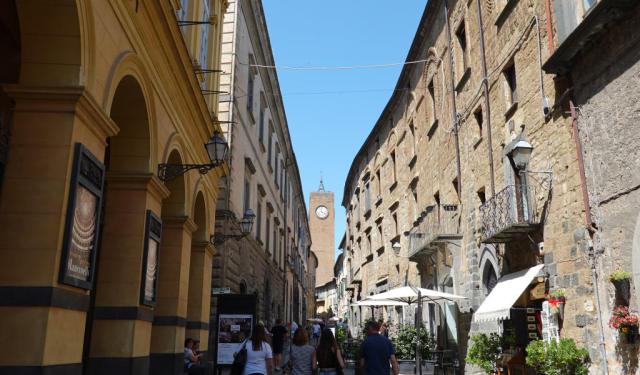
Pozzo della Cava (Quarry Well Archaeological Complex), Orvieto (must see)
The Quarry Well is entirely excavated from the rock on which Orvieto is built and consists of two interconnected sections, reaching a depth of 36 meters. These two sections include a small rectangular Etruscan well and a round Renaissance well designed for spring water.
The history of Quarry Well is closely tied to Pope Clement VII, who sought refuge in Orvieto in 1527 during the Sack of Rome. Concerned about the city's water supply in case of a siege, the Pope ordered the excavation and adaptation of this well to reach the spring water. Additionally, Pope Clement VII commissioned the construction of the famous St. Patrick's Well on the opposite side of the town.
The rediscovery of Quarry Well came in December 1984 when Tersilio Sciarra uncovered the well after more than three centuries of disuse. At that time, the well was only 25 meters deep, filled with earth and debris. The restoration work began in the spring of 1996, aiming to return the structure to its original appearance.
In addition to the well itself, visitors to Quarry Well can explore nine caves surrounding it. These caves offer insights into medieval life, including the use of small pits known as "butti" for disposing of rubbish. The caves also reveal remnants of ancient Etruscan burial tombs and medieval foundations, such as a large pillar that supported the medieval Filippeschi tower.
One of the most impressive underground chambers measures 14 meters and served as a tuff quarry in the 18th and 19th centuries. Within this chamber, you'll find an Etruscan tunnel, a second Etruscan well, and various medieval and Renaissance artifacts. Notably, there are two kilns for pottery: a large medieval kiln from a ceramic workshop featuring majolica and terracotta artifacts, and a smaller kiln used for firing precious Renaissance "lusterware" pottery.
The underground spaces also include rooms excavated during the Middle Ages for the production and storage of Orvieto's renowned wines. These rooms feature staircases and repurposed Etruscan cisterns that collected rainwater from nearby rooftops.
During the Christmas season, the Quarry Well hosts a special event called "The Christmas Crib in the Well," featuring self-moving life-size characters and creating a new experience each year.
The history of Quarry Well is closely tied to Pope Clement VII, who sought refuge in Orvieto in 1527 during the Sack of Rome. Concerned about the city's water supply in case of a siege, the Pope ordered the excavation and adaptation of this well to reach the spring water. Additionally, Pope Clement VII commissioned the construction of the famous St. Patrick's Well on the opposite side of the town.
The rediscovery of Quarry Well came in December 1984 when Tersilio Sciarra uncovered the well after more than three centuries of disuse. At that time, the well was only 25 meters deep, filled with earth and debris. The restoration work began in the spring of 1996, aiming to return the structure to its original appearance.
In addition to the well itself, visitors to Quarry Well can explore nine caves surrounding it. These caves offer insights into medieval life, including the use of small pits known as "butti" for disposing of rubbish. The caves also reveal remnants of ancient Etruscan burial tombs and medieval foundations, such as a large pillar that supported the medieval Filippeschi tower.
One of the most impressive underground chambers measures 14 meters and served as a tuff quarry in the 18th and 19th centuries. Within this chamber, you'll find an Etruscan tunnel, a second Etruscan well, and various medieval and Renaissance artifacts. Notably, there are two kilns for pottery: a large medieval kiln from a ceramic workshop featuring majolica and terracotta artifacts, and a smaller kiln used for firing precious Renaissance "lusterware" pottery.
The underground spaces also include rooms excavated during the Middle Ages for the production and storage of Orvieto's renowned wines. These rooms feature staircases and repurposed Etruscan cisterns that collected rainwater from nearby rooftops.
During the Christmas season, the Quarry Well hosts a special event called "The Christmas Crib in the Well," featuring self-moving life-size characters and creating a new experience each year.
Want to visit this sight? Check out these Self-Guided Walking Tours in Orvieto. Alternatively, you can download the mobile app "GPSmyCity: Walks in 1K+ Cities" from Apple App Store or Google Play Store. The app turns your mobile device to a personal tour guide and it works offline, so no data plan is needed when traveling abroad.
Pozzo della Cava (Quarry Well Archaeological Complex) on Map






Sight Name: Pozzo della Cava (Quarry Well Archaeological Complex)
Sight Location: Orvieto, Italy (See walking tours in Orvieto)
Sight Type: Attraction/Landmark
Guide(s) Containing This Sight:
Sight Location: Orvieto, Italy (See walking tours in Orvieto)
Sight Type: Attraction/Landmark
Guide(s) Containing This Sight:
Walking Tours in Orvieto, Italy
Create Your Own Walk in Orvieto
Creating your own self-guided walk in Orvieto is easy and fun. Choose the city attractions that you want to see and a walk route map will be created just for you. You can even set your hotel as the start point of the walk.
Orvieto Introduction Walking Tour
Some 100 kilometers north of Rome, in the picturesque region of Umbria, lies the old town of Orvieto overlooking the Paglia valley from atop a volcanic plateau. The name "Orvieto" stems from “urbs vetus” which means “ancient town” in Latin. Indeed, Orvieto is old, with its roots traced to Etruscan times, circa the 9th century BC.
Despite having been a major center of Etruscan... view more
Tour Duration: 2 Hour(s)
Travel Distance: 3.4 Km or 2.1 Miles
Despite having been a major center of Etruscan... view more
Tour Duration: 2 Hour(s)
Travel Distance: 3.4 Km or 2.1 Miles

